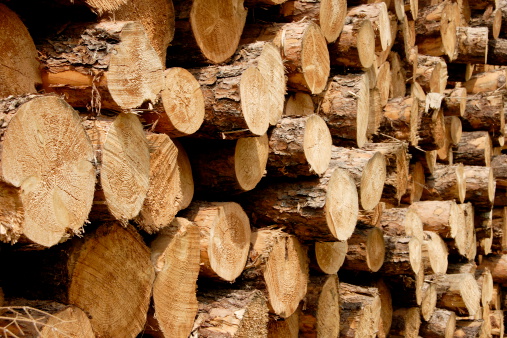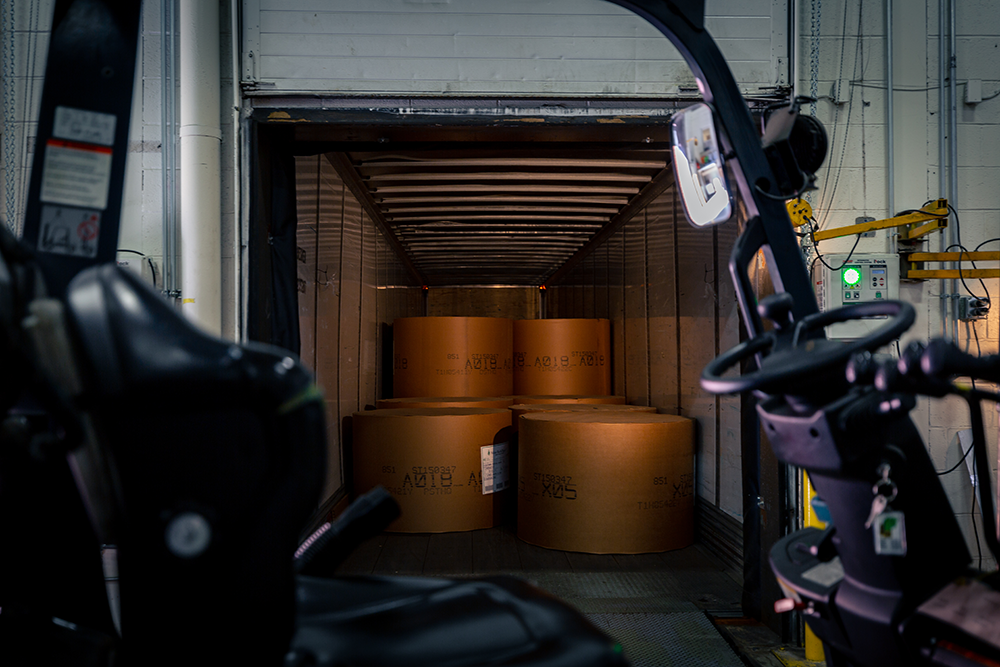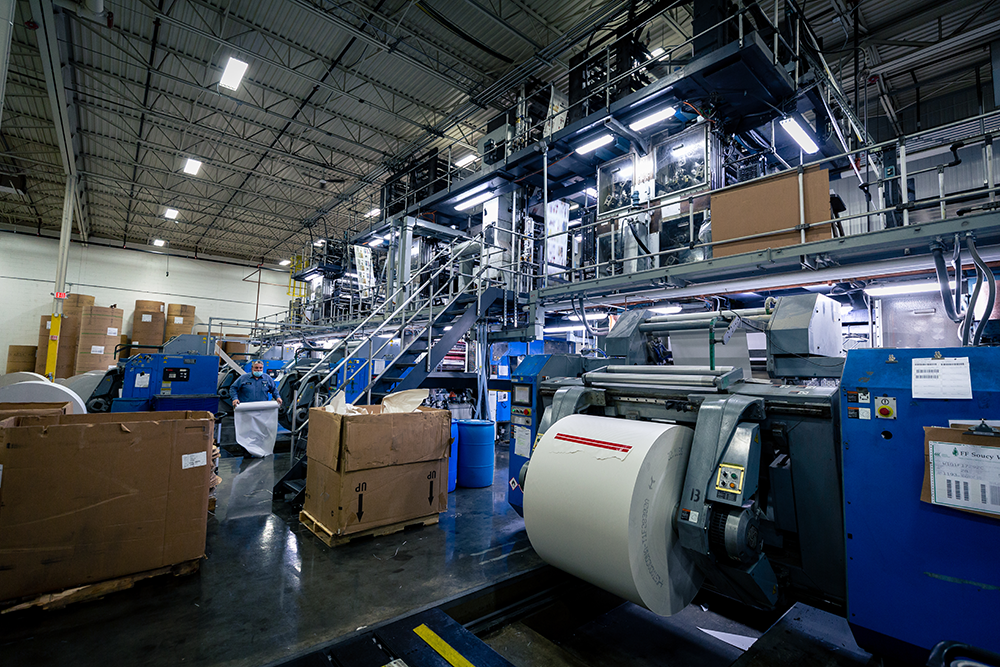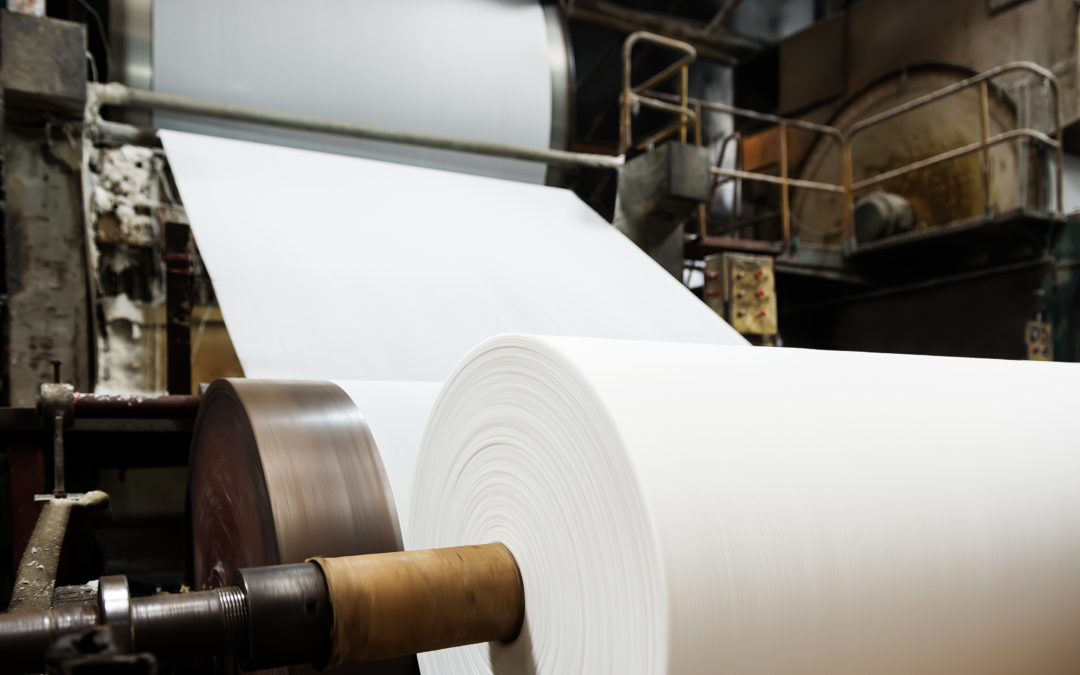This article is a brief guide to newsprint, the essential component of quality commercial printing on a high-speed offset press. If your business needs commercial printing services in Lancaster County, Pennsylvania, or anywhere in the mid-Atlantic region, this guide will provide information on the attributes of newsprint that will affect the quality of your print job. Materials printed on newsprint are essential for marketing and communication in many businesses including higher education, healthcare, retail, financial, pharmaceutical, and news media. In this article, we’ll review the history of newsprint, the attributes and qualities of newsprint, current news regarding cost and supply, and optimal uses of newsprint.
A brief history of newsprint
Newsprint has long been the workhorse paper of news media and commercial printing. The use of wood pulp to make newsprint paper was simultaneously developed by two men: Charles Fenerty of Nova Scotia and Friedrich Gottlob Keller of Germany.
Fenerty was the son of a Nova Scotia lumberman. As a boy, Fenerty brought logs from his family’s forest into Halifax to be sold. In Halifax, the young man observed the processes of both lumber mills and paper mills. Paper mills at that time used rags, cotton, hemp and other natural fibers to make paper, but the supply of these fibers was limited. Nova Scotia, with its vast forests, had an abundance of softwood, such as spruce and pine, which contained usable fiber. Fenerty developed a process to break down softwood into fibers, then to refine and bleach those fibers to make paper. Fenerty succeeded in producing wood pulp-based paper in 1844.
Keller was a weaver, machinist, and inventor in Saxony, Germany. Keller developed a wood pulping machine (called a wood cut machine) in the mid-1800s and was able to produce paper from wood in 1844, like Fenerty. Unlike Fenerty, Keller patented his machine in partnership with a Heinrich Voelter. Later, the patent passed fully to Voelter and by the 1850s newsprint paper from wood pulp was being produced in volume for use in newspapers. By the early 20th century, books also transitioned to the use of newsprint instead of rag-based papers.
The physical qualities of newsprint
Newsprint is primarily made of softwood pulp that has been mechanically processed and chemically treated to strengthen the wood fibers. The product may also contain recycled fibers, talc, kaolin clay, and/or calcium carbonate. These fillers are used to adjust the finish and color of the paper.
Newsprint has the following characteristics:
- Cost – Relative to other types of paper, newsprint has traditionally been considered a low-cost paper product. However, newsprint costs have been rising quickly in recent years, as will be discussed later in this article.
- Strength – The strength of newsprint means that it will not break when stretched between rolls on large commercial printing presses. This quality is also referred to as “runnability” since the strength of newsprint allows the printing press to keep running. Commercial newsprint rolls are about a quarter of a mile long, which requires a lot of strength to remain intact during the high-speed commercial printing process.
- Color/brightness – Newsprint color ranges from off-white (or grey) to near-white in color, but it can be dyed to any color. Newsprint typically has a brightness value of 62-65%, meaning it reflects that proportion of light. By contrast, office paper reflects 80-95% of light.
- Weight – Newsprint’s weight range is roughly 28 to 65 GMS (grams per square meter), which makes it a lightweight paper. Newsprint is ideal for products with many pages that need to remain lightweight such as retail catalogues, annual reports, advertising supplements, training manuals, standard operating procedure manuals, telephone directories, business reports, college catalogues, shopping circulars, and newspapers.
- Roll length – Rolls of newsprint are typically 1,440 feet long, just over a quarter mile. This length feeds into offset web printing presses in long, unbroken sheets that allow for fast and efficient printing. Presses that use rolls of paper are also referred to as web presses, as opposed to sheet fed presses (which use individual sheets of paper).
- Opacity – Newsprint has high opacity so that ink will not show through the paper. Opacity is measured by how much light can pass through the paper. Newsprint blocks 90-94% of light from passing through. By contrast, tracing paper blocks 25-40% of light from passing through. High opacity is achieved through a combination of paper thickness, fillers, and bleaching.
- Ink absorption – Newsprint needs to absorb ink quickly so that the ink does not smudge during the high-speed commercial printing process. In a coldset press, ink dries almost instantaneously without exposure to heaters. In a heatset press, the pages must be run through a heater to dry the ink. Ink absorption rates are affected by the fillers in the paper as well as the degree of calendaring (see below).
- Finish – Calendaring is the process of creating a smooth finish on newsprint by running the paper through metal rollers. Newsprint can also be supercalendered by running it through additional rollers to make it even thinner and smoother. Newsprint is an uncoated paper, but supercalendering creates a finish that is close to glossy, yet less expensive. Supercalendared newsprint is a good choice for magazines that require sharp color reproduction and a higher end look and feel.
- Grades – There are three basic grades of newsprint available to commercial printing facilities:
- Standard – This is the regular paper we think of for newspapers. It is thin and is called “non-archivable” since it loses brightness and becomes brittle over years of storage.
- Improved – This is a thicker and brighter type of newsprint that holds color better than standard newsprint.
- Specialty – At the top end of the thickness and brightness scale, this type of newsprint absorbs/displays color the best of the three grades.
Declining Newsprint Supply
Newsprint manufacturers have been facing declining demand for their paper products for the past decade as an increasingly digital society has reduced its use of paper. This has resulted in the closure of pulp and paper mills worldwide. In 2015, Fastmarkets RISI reported that 60 mills had been closed in 2013-2014, and 33 mills had idled. In 2021 alone, Paper Money listed over 40 mills that were cutting back or closing. The drop in demand was accelerated by the Covid pandemic, which pushed office workers into remote home offices and pushed students into online classes. These events further reduced the demand for paper. Fisher International estimated that the Covid pandemic “reduced paper and market pulp production by roughly 2.5MM tons” in North America.

And, in addition to closed or idled paper manufacturing plants, paper producers have also switched their production from paper to packaging. Global packaging demand has been rising due to increasing consumer use of e-commerce and shipping, especially during Covid lockdowns when consumers could not shop at brick-and-mortar stores.
Demand for newsprint began to increase again in 2021 as economies strengthened, but paper supply was no longer as readily available. In Q3 of 2021, Bloomberg reported on a global newsprint paper shortage that was affecting retailers just as they were preparing their holiday season catalogues for mailing. Bloomberg reported that “nearly one-fifth of 2019 levels [of newsprint] has come offline since the start of last year.” Printweek reported that paper would need to be ordered with long lead times and that, even with advanced planning, paper might simply be unavailable: “12 weeks ahead, and potentially 14-16 weeks ahead, with some mills reporting that all their production for the remainder of the year was now allocated.” A contributing factor to the need to order paper ahead, as reported by Laurel & Narrow Web, was the global shipping and logistical crisis which has made it increasingly difficult for commercial printers to receive the paper supplies they have been able to order.
Given the challenges of the global paper supply shortage, Susquehanna Printing has worked hard to maintain a stock of roughly 1,000 newsprint rolls to support our average usage of 750 rolls per month. These rolls are stored in an area that is clean, not exposed to sunlight, acid-free, and an optimal temperature and humidity range, per supplier recommendations.
Rising Newsprint Prices
While newsprint has historically been considered a low-cost product, The Economist reported in early 2021 that newsprint prices had increased dramatically, which followed two prior years in which prices had already been steadily rising. As mentioned above, newsprint paper supply has declined globally over the past decade. As a result, when economies began to rebound in 2021, supply could not keep up with demand and newsprint prices soared.
According to The Economist, another factor in the increase in newsprint prices has been rising energy prices. Partially because of increased energy prices, The Economist reported that the global increases in newsprint costs ranged from 50%-70% in Europe, to 20%-45% in Asia, and 20%-30% in North America. Similarly, Fastmarkets RISI reported that all inputs in the paper making process were rising in cost. These inputs include transportation, chemicals, CO2 allowances, and wood pulp.
As an example of the direct impact on commercial printers, Laurel & Narrow Web reported monthly price increases coming from just one supplier: “Asia Pulp & Paper (APP) which is one of the largest pulp and paper companies in the world, per their notification dated 22nd January 2021, increased prices of all grades of paper by $100 per ton then on 1st February 2021 they increased the prices by another $100 per ton and also withdrew the reel discount they were offering, yet again on 1st March 2021 they increased the prices by yet another $150 per ton.” Cost increases of this nature are a significant challenge to commercial printers and their customers.
These cost increases have ramifications for many types of businesses. News media companies have already suffered years of declining ad revenue and subscription revenue and will be hard pressed to absorb newsprint price increases. Any business that uses commercial newsprint printing to produce essential business publications will also find that newsprint prices have increased, even while commercial printers try to offset these costs through developing efficiencies.
Products for which newsprint is ideal
The information in this article demonstrates that, as-of the end of 2021, there is a global decrease in paper supply and an increase in paper prices. In light of these price increases, newsprint is an even more important paper for commercial printing than ever before. Even though newsprint prices are up significantly, newsprint is still a more affordable paper than any other paper. The business necessity to consider newsprint, given its relative affordability to other papers, remains intact.
In general, commercial offset printing (coldset or heatset) on newsprint is a great fit for any project that is high volume. Offset printing produces pages at a rate of up to 18,000 per minute, compared to 100-200 pages per minute for a digital press. Offset printing also provides excellent, consistent color reproduction. Newsprint is a lightweight paper that is perfect for products with a high page count. Newsprint comes in a range of brightness levels to produce a result that is close to the brightness of office paper.
At Susquehanna Printing, we are experts in coldset newsprint printing. We will work with your team from design through distribution to ensure your print job is executed perfectly. Some of the steps we take include:
- Design guidance – Our pre-press team will work closely with you to review your design choices in font, images, color, and layout to make sure that the finished product will look the best. We use a CMYK printing process, which means that any color desired can be created from a mixture of cyan, magenta, yellow and black inks. We will also carefully review your page layout to avoid common issues such as having dark areas across from light areas. Changing the layout to so that these pages are not across from each other removes the potential for ink to transfer from dark to light areas.
- Quality control – This critical step is accomplished through careful review of all files submitted. Our team has the years of expertise to check your design for any possible issues before printing, such as images that are low resolution. Plus, you will have the opportunity to approve proofs before printing.
- Flexible printing power – Our Goss Universal 70 press is best in class for speed, flexibility, and precision, with the option to run as two separate presses or as one. Your product will be folded and stacked as it comes off the press, ready for insertion and/or distribution.
- Full finishing shop – We have a full finishing team to handle your folding, binding, and insertion needs. Your printed product can be bound to your specifications and then inserted by our state-of-the-art Muller Martini Alphaliner and Heidelberg 632 inserters. Our inserters are high speed and high capacity, with up to 24 in 1 capability.
- Mailing and distribution – Our fleet of trucks can deliver your product to your facility, within the mid-Atlantic region. We also have postal experts on-site and a detached mail unit (DMU) in our building, staffed by a U.S. Postal Service clerk, so that we can put your product directly into the mail stream. We can advise you on how to get the most in postage discounts. And, if you need a prospect list to mail your product to, we offer affordable, targeted list procurement
- Marketing – Need to get your product into wider circulation? Need to raise brand awareness of your business? We are part of LNP Media Group, a full-service marketing agency. Our print and digital marketing experts have a proven track record in planning, executing, and optimizing campaigns in any medium, including newspaper, display ads, paid search, SEO, geo-fencing, OTT/CTV, Facebook, Instagram, Twitter, and much more.


Below are examples of products that are an excellent fit for commercial coldset printing on newsprint.
Newspapers and periodicals (broadsheets and tabloids) – One of the most common uses for newsprint is, naturally, a newspaper or periodical. Newspapers and periodicals can be printed in two styles: broadsheet or tabloid. Broadsheet is the larger format, with a long sheet folded in half vertically to create four pages 12 inches wide by 22.75 inches long. Tabloid is a smaller format with the pages folded horizontally. Tabloids are roughly 11 by up to 17 inches.
Many types of industries publish periodicals, such as financial, agricultural, pharmaceutical, educational (primary, secondary and higher education), automotive/equipment, real estate, auction, and scholarly journals. Periodical printing in Lancaster PA, especially in tabloid format, is a great way to showcase your company’s products, services, information, history, or inventory.
Catalogues for retail, colleges/universities, real estate, automotive, office supplies, equipment or auctions are a great fit for newsprint. Catalogues contain an abundance of detailed information and many images, potentially spanning hundreds of pages. Using coldset commercial printing on newsprint for catalogues makes the final product lightweight, visually appealing, and affordable. Plus, given the high speed at which offset printers run, the production time is significantly less than it would be with a digital press.
To have Susquehanna Printing print your catalogue you simply need to provide your artwork according to our pre-press guidelines. We have a full quality control process in place so you will have the opportunity to review detailed proofs of your print job before it is printed. We also have a highly skilled mailing team who can help you get the highest possible postage discounts. Our facility is a detached mail unit (DMU) with a U.S. Postal Service clerk on-site, which means your catalogue can enter the mail stream right off the printer. Printing your catalogue at Susquehanna Printing will save your business time, money, and headaches.
Shopping coupons and circulars – Weekly shopping circulars are a proven method of driving traffic to your store. Research demonstrates that 66% of U.S. adults use printed circular coupons for shopping, either from the newspaper, in-store, or from a TMC (total market coverage) mailer. Why are coupons and sales flyers so popular? Because shoppers enjoy the routine of finding the latest retail deals.
Whether for grocery, pharmacy, sports, or apparel, circulars need to be printed quickly and must have excellent color reproduction to make items visually appealing. Shopping circulars also need to be light weight for mailing via a TMC product or for insertion into a newspaper. Double-sided printing of your circulars on newsprint is the ideal way to maximize these attributes while keeping costs down. Susquehanna Printing’s coldset press can also fold your shopping circular and insert into LNP, the local Lancaster newspaper, or into the Lancaster County TMC product, Pocket.
Annual reports – Your company’s annual report is an important document that represents a summary of your business year. Use your annual report to create a narrative of what your company has accomplished and its goals and direction for the future. Annual reports may be produced by for-profit and non-profit companies, as well as educational institutions. Annual reports need to be fully customized to the exact look and feel that best represents your business’s brand. Annual reports can run to a hundred pages or more and contain graphs and charts that need to look sharp. Susquehanna Printing offers many binding options for your annual report, including saddle stitched, spiral bound, perfect bound, or 3-hole.
Annual reports may need to be mailed to investors, board members, donors and/or shareholders and thus need to be lightweight to keep postage as low as possible. For annual reports, supercalendered newsprint, which has a smooth finish and light GSM, may be a good option to maintain a high-end professional look with the best cost savings.
Conclusion
Commercial printing is facing challenges of both supply and demand of paper, as never before. Paper prices are skyrocketing, and paper shortages are affecting printers worldwide. The economic re-opening of 2021 demonstrated that there is still plenty of need for business print services.
Within this unprecedented set of factors, Susquehanna Printing is your best resource for a fair, transparent relationship that maximizes the return on your printing investment. We offer an all-in-one printing and fulfillment service to save your business time and money, while achieving the highest possible quality. We work with local companies in Lancaster, Pennsylvania, in neighboring states such as New York, Maryland, Virginia, West Virginia, Ohio, Delaware, and New Jersey. Contact us today to start a great working relationship for all your commercial printing and mailing needs.

